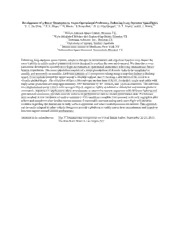
NASA Technical Reports Server (NTRS) 20110014014: Development of a Rover Simulation to Assess Operational Proficiency Following Long Duration Spaceflights PDF
Preview NASA Technical Reports Server (NTRS) 20110014014: Development of a Rover Simulation to Assess Operational Proficiency Following Long Duration Spaceflights
Development of a Rover Simulation to Assess Operational Proficiency Following Long Duration Spaceflights Y. E. De Dios, 1,2 S. L. Dean, 1,2 N. Davis, 3 J. Rosenthal, 3 H. G. MacDougall, 4 S. T. Moore5 and S. J. Wood,1,6 1 NASA Johnson Space Center, Houston TX, 2 Wyle Integrated Science and Engineering Group, Houston TX 3Tietronix Software, Inc., Houston TX 4 University of Sydney, Sydney Australia 5 Mount Sinai School of Medicine, New York NY 6 Universities Space Research Association, Houston TX Following long-duration space transits, adaptive changes in sensorimotor and cognitive function may impair the crew’s ability to safely control pressurized rovers designed to explore the new environment. We describe a rover simulation developed to quantify post-flight decrements in operational proficiency following International Space Station expeditions. The rover simulation consists of a serial presentation of discrete tasks to be completed as quickly and accurately as possible. Each task consists of 1) perspective taking using a map that defines a docking target, 2) navigation toward the target around a Martian outpost, and 3) docking a side hatch of the rover to a visually guided target. The simulator utilizes a Stewart-type motion base (CKAS, Australia), single seat cabin with triple scene projection covering approximately 150° horizontal by 40° vertical, and joystick controller. The software was implemented using Unity3 with next-gen PhysX engine to tightly synchronize simulation and motion platform commands. Separate C# applications allow investigators to customize session sequences with different lighting and gravitational conditions, and then execute tasks to be performed as well as record performance data. Preliminary tests resulted in low incidence of motion sickness (<15% unable to complete first session), with only negligible after effects and symptoms after familiarization sessions. Functionally relevant testing early post-flight will develop evidence regarding the limitations to early surface operations and what countermeasures are needed. This approach can be easily adapted to other vehicle designs to provide a platform to safely assess how sensorimotor and cognitive function impact manual control performance. Abstract to be submitted to: The 3rd International Symposium on Visual Image Safety, September 22-23, 2011, The Red Rock Hotel in Las Vegas, NV
